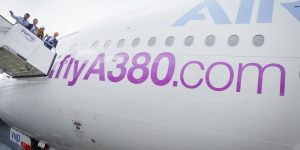Etihad Airways Flying into Troubled Skies
Etihad Airways might have just won a trio of Skytrax awards but the business fundamentals for the Gulf carrier are not as rosy as the cabins might let on
The recent Skytrax hat-trick win for Etihad Airways First Class notwithstanding, the fundamentals of Etihad Airways might not be as rosy as the optics show. For a long time, Etihad has been buying its way into a leading industry position by buying stakes in regional carriers. Backed by alleged state-subsidies to a tune of US$42 billion, Etihad Airways pursued an aggressive strategy, in some ways leap frogging its larger, more established peers Emirates Airline and Qatar Airways. Etihad Airways does this by acquiring shareholdings in airlines and using code-sharing partnerships, dramatically growing its network. So aggressive is the Abu-Dhabi based firm to fill its seats with code-share passengers that its rivals in the Eurozone and US are complaining of unfair competition. Yet, for all its Skytrax wins and glowing First Class reviews, recent events might show that Etihad Airways is flying into troubled skies.

Etihad Airways Flying into Troubled Skies
In the last 10 years, Middle Eastern carriers like Etihad, Emirates and Qatar have evolved from being fringe players to “next big thing” in airlines as they seduced loyal travellers with an unbeatable combination of world class service, swanky cabin settings and unbelievable low prices, beating even the more established carriers like Singapore Airlines at their own game.
Etihad Airways, the younger of the three Middle Eastern carriers managed to dramatically expand its network spending over US$1 billion on carriers like Air Seychelles, Air Serbia, Jet Airways, Virgin Australia and Alitalia. But, not all of Etihad’s acquisitions have turned out well.
With 49% acquired in 2014, Etihad had intended to turn the troubled Italian carrier Alitalia around, a company which had not reported profit since 2002. Slightly under three years later, the Etihad Airways announced on May 2 that it was “no longer willing to invest in Alitalia” after the company failed to secure support for restructuring. As a result, the Italian carrier’s board asked to be put under special administration, a step on the path of technical bankruptcy.
This news comes amid other debacles involving further capital injections to their many shareholdings and legal tussles involving Germany’s AirBerlin, a carrier Etihad Airways purchased 29% of in 2011, when Germany’s transport ministry took issue over the joint code-sharing agreement raising concerns that it violated a German bi-lateral agreement with the United Arab Emirates. Thus, it stands to reason that with aggressive acquisition, one requires extensive time and management to go into (which Etihad doesn’t have) and manage what made these carriers cost-effective to acquire stakes in the first place. OAG, an aviation consultancy, estimates that as high as 92% of Etihad’s worldwide flights operate on other airlines under a code-sharing agreement.

Etihad Aviation Group President and CEO James Hogan will be stepping down in the second half of 2017
This comes amid news that Etihad Aviation Group President and CEO James Hogan will be stepping down in the second half of 2017. A 10 year veteran of Etihad Airways, Hogan assumed the role of President during the formation of Etihad Aviation Group. While as CEO of Eithad Airways, Hogan was instrumental in the airline’s business strategy for acquiring stakes in regional carriers to expand Etihad’s reach. That said, it cannot be concluded that Hogan’s departure was a result of the strategy implemented, after all, the combination of stake acquisition and code-share had filled Etihad planes while giving it the revenues to become a global contender while driving passenger traffic through Abu Dhabi International Airport.
Yet, while most aviation insiders do not question Hogan’s legacy of growing Etihad to what it is today. However, some do wonder if the pursuit of over 40 partners has been all positive news, especially with the very public dramas facing with Alitalia and AirBerlin. On the topic of passenger traffic through Abu Dhabi International Airport, the numbers are not so rosy either.
While the home airport of Etihad Airlines suffered a mere 1% decline from 1.92 million passengers, to 1.9 million, it was concerning amid the uptick of 1.3% more aircraft movements. Add this fact in relation to the news that the biggest Gulf carrier Emirates had just reported a 75% fall in profits in the first half of its 2016 fiscal year and the picture is a troubling one.
It is true that May 2017 figures for Abu Dhabi International Airport show an increase to 2 million passengers, this is widely considered to be on the back of rising traffic from the Umrah season – the annual pilgrimage made by followers of Islam of which Saudi Arabia. Furthermore, Umrah has been extended past Ramadan, for a whole month and it remains to be seen if the growth can be sustained beyond seasonal travel.
Hogan’s departure is joined by Etihad Aviation Group CFO James Rigney, where they will both head to an investment company, meanwhile Etihad Aviation Group has embarked on a global search for a new group CEO and CFO.
With corporate restructuring and layoffs beginning Dec 2016 due to lower profits and allegations of anti-competitive practices mounting with many carriers claiming breach of international open skies agreements; the business of Etihad Airways might not be looking as rosy as their cabins or service standards.









